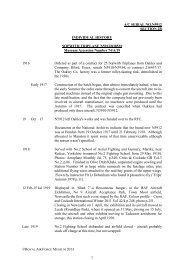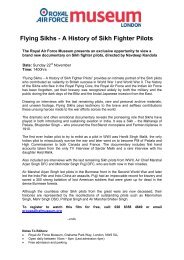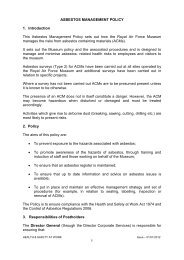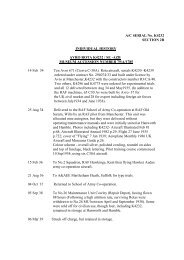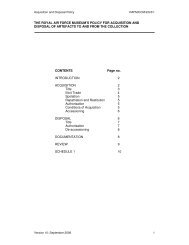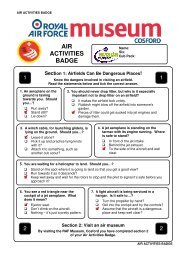©Copyright 2013 - Professor Richard Morris & The Trustees of the ...
©Copyright 2013 - Professor Richard Morris & The Trustees of the ...
©Copyright 2013 - Professor Richard Morris & The Trustees of the ...
Create successful ePaper yourself
Turn your PDF publications into a flip-book with our unique Google optimized e-Paper software.
<strong>the</strong> job was done, but sometimes beyond that point to make sure that it really had beendone. His unwillingness to step back from operations might be seen as part <strong>of</strong> thattenacity. Where did it come from?Gibson had been born in India in 1918. He was <strong>the</strong> youngest <strong>of</strong> three children. <strong>The</strong> eldestwas Alick, born in 1915, who had been followed by a sister, Joan. <strong>The</strong>ir parents hadmarried in 1913. Eighteen years lay between <strong>the</strong>m. Alexander Gibson, Guy Gibson’sfa<strong>the</strong>r, was 37 years old when he proposed to nineteen-year-old Leonora Mary Strike, <strong>the</strong>daughter <strong>of</strong> a Cornish master mariner.Page | 4Alexander had been born in Moscow in 1874. His fa<strong>the</strong>r, Guy Gibson’s grandfa<strong>the</strong>r, hadtrained as an engineer in Lancashire and <strong>the</strong>n worked in St Petersburg and Moscow runningworks producing candles and soap. If we look fur<strong>the</strong>r back <strong>the</strong> great-grandfa<strong>the</strong>r was alsoan engineer, who had worked both in Sweden and Russia, and for a time managed a papermill in St Petersburg. We thus see a cyclical pattern: <strong>the</strong> Gibsons are a dynasty <strong>of</strong>engineers and technocrats who train and marry at home, migrate to work in industry andraise <strong>the</strong>ir families abroad, and retire to Britain in middle age.Gibson’s fa<strong>the</strong>r, Alexander, continued <strong>the</strong> pattern. In his late teens he went to studyforestry at Cooper’s Hill college, and <strong>the</strong>n to work as an <strong>of</strong>ficer in <strong>the</strong> Indian ForestService. In India he specialised in <strong>the</strong> industrial extraction <strong>of</strong> turpentine and o<strong>the</strong>rchemicals from timber productsGibson’s parents set up home in a spacious bungalow in generous grounds on <strong>the</strong> edge <strong>of</strong>Shimla, summer capital <strong>of</strong> British India. Situated in <strong>the</strong> Himalayan foothills Shimla waspolitically important and scenically attractive. It was also a place <strong>of</strong> sport, <strong>of</strong> socialintrigue, dancing and desires. Rudyard Kipling knew about Shimla’s allures and risks:By Docket, Billetdoux, and File,By Mountain, Cliff, and Fir,By Fan and Sword and Office-box,By Corset, Plume, and Spur,By Riot, Revel, Waltz, and War,By Women, Work, and Bills,By all <strong>the</strong> life that fizzes<strong>The</strong> everlasting Hills,If you love me as I love youWhat pair so happy as we two!<strong>©Copyright</strong> <strong>2013</strong> - <strong>Pr<strong>of</strong>essor</strong> <strong>Richard</strong> <strong>Morris</strong> & <strong>The</strong> <strong>Trustees</strong> <strong>of</strong> <strong>the</strong> Royal Air Force Museum.
Operation Market-Garden, <strong>the</strong> Allies’ attempt to seize a crossing <strong>of</strong> <strong>the</strong> Lower Rhine byairborne assault, and drive a path to it from north Belgium. At bomber stations inLincolnshire <strong>the</strong>re were rumours that <strong>the</strong> war might end within weeks. Two days laterGibson took an opportunity to lead a 5 Group raid on <strong>the</strong> adjoining towns <strong>of</strong>Mönchengladbach and Rheydt in North Rhine-Westphalia, close to <strong>the</strong> Dutch border. Heflew in a Mosquito - a fast, agile aircraft ideally suited to <strong>the</strong> task <strong>of</strong> precisely marking atarget with flares. Gibson’s task on this evening was to oversee <strong>the</strong> marking <strong>of</strong> Rheydt andto coordinate <strong>the</strong> attack. <strong>The</strong>re were snags with <strong>the</strong> marking, but <strong>the</strong>se were overcomeand from <strong>the</strong> attackers’ point <strong>of</strong> view <strong>the</strong> raid was relatively uneventful.Page | 7Gibson turned for home a little after ten p.m. About twenty minutes later his aircraftcrashed and exploded close to <strong>the</strong> Dutch town <strong>of</strong> Steenbergen. <strong>The</strong> remains <strong>of</strong> Gibson andhis navigator, Sqn Ldr James Warwick, were buried in <strong>the</strong> town’s Roman Catholiccemetery on <strong>the</strong> following day.A week later Churchill asked <strong>the</strong> Air Ministry what had happened to his belovedDambuster. He received no useful answer, and <strong>the</strong>re has been debate ever since aboutwhat caused <strong>the</strong> crash. However, <strong>the</strong> records <strong>of</strong> reports from crews who had taken part,collected at debriefings after <strong>the</strong> raid, and analysis <strong>of</strong> <strong>the</strong>se and o<strong>the</strong>r sources at BomberCommand in following days show <strong>the</strong> contemporary assessment to have been that Gibsonwas shot down by flak.Harris described Gibson as ‘great a warrior as <strong>the</strong>se Islands have ever bred’. He was o<strong>the</strong>rthings too. Despite his forceful reputation history remembers him as a sympa<strong>the</strong>tic figure,and as one <strong>of</strong> <strong>the</strong> most committed operational leaders that <strong>the</strong> RAF has ever produced.Gibson’s book Enemy Coast Ahead remains essential reading for its au<strong>the</strong>ntic accent <strong>of</strong>wartime Bomber Command. And for <strong>the</strong> public today he remains as much <strong>the</strong> national heroas he instantly became on that Tuesday in May 1943 when our grandparents opened <strong>the</strong>irnewspapers and saw his face, with its winning smile.<strong>©Copyright</strong> <strong>2013</strong> - <strong>Pr<strong>of</strong>essor</strong> <strong>Richard</strong> <strong>Morris</strong> & <strong>The</strong> <strong>Trustees</strong> <strong>of</strong> <strong>the</strong> Royal Air Force Museum.



